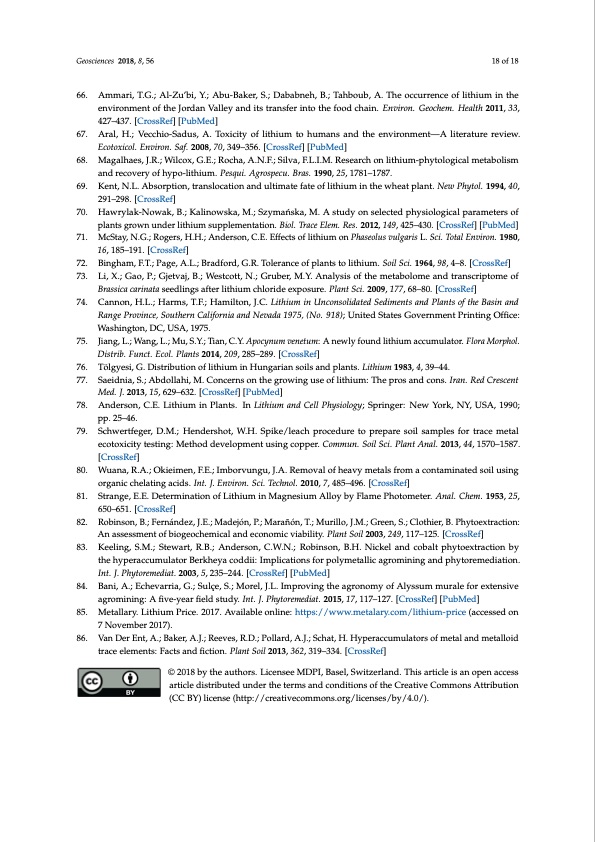
PDF Publication Title:
Text from PDF Page: 018
Geosciences 2018, 8, 56 18 of 18 66. Ammari, T.G.; Al-Zu’bi, Y.; Abu-Baker, S.; Dababneh, B.; Tahboub, A. The occurrence of lithium in the environment of the Jordan Valley and its transfer into the food chain. Environ. Geochem. Health 2011, 33, 427–437. [CrossRef] [PubMed] 67. Aral, H.; Vecchio-Sadus, A. Toxicity of lithium to humans and the environment—A literature review. Ecotoxicol. Environ. Saf. 2008, 70, 349–356. [CrossRef] [PubMed] 68. Magalhaes, J.R.; Wilcox, G.E.; Rocha, A.N.F.; Silva, F.L.I.M. Research on lithium-phytological metabolism and recovery of hypo-lithium. Pesqui. Agrospecu. Bras. 1990, 25, 1781–1787. 69. Kent, N.L. Absorption, translocation and ultimate fate of lithium in the wheat plant. New Phytol. 1994, 40, 291–298. [CrossRef] 70. Hawrylak-Nowak,B.;Kalinowska,M.;Szyman ́ska,M.Astudyonselectedphysiologicalparametersof plants grown under lithium supplementation. Biol. Trace Elem. Res. 2012, 149, 425–430. [CrossRef] [PubMed] 71. McStay, N.G.; Rogers, H.H.; Anderson, C.E. Effects of lithium on Phaseolus vulgaris L. Sci. Total Environ. 1980, 16, 185–191. [CrossRef] 72. Bingham, F.T.; Page, A.L.; Bradford, G.R. Tolerance of plants to lithium. Soil Sci. 1964, 98, 4–8. [CrossRef] 73. Li, X.; Gao, P.; Gjetvaj, B.; Westcott, N.; Gruber, M.Y. Analysis of the metabolome and transcriptome of Brassica carinata seedlings after lithium chloride exposure. Plant Sci. 2009, 177, 68–80. [CrossRef] 74. Cannon, H.L.; Harms, T.F.; Hamilton, J.C. Lithium in Unconsolidated Sediments and Plants of the Basin and Range Province, Southern California and Nevada 1975, (No. 918); United States Government Printing Office: Washington, DC, USA, 1975. 75. Jiang, L.; Wang, L.; Mu, S.Y.; Tian, C.Y. Apocynum venetum: A newly found lithium accumulator. Flora Morphol. Distrib. Funct. Ecol. Plants 2014, 209, 285–289. [CrossRef] 76. Tölgyesi, G. Distribution of lithium in Hungarian soils and plants. Lithium 1983, 4, 39–44. 77. Saeidnia, S.; Abdollahi, M. Concerns on the growing use of lithium: The pros and cons. Iran. Red Crescent Med. J. 2013, 15, 629–632. [CrossRef] [PubMed] 78. Anderson, C.E. Lithium in Plants. In Lithium and Cell Physiology; Springer: New York, NY, USA, 1990; pp. 25–46. 79. Schwertfeger, D.M.; Hendershot, W.H. Spike/leach procedure to prepare soil samples for trace metal ecotoxicity testing: Method development using copper. Commun. Soil Sci. Plant Anal. 2013, 44, 1570–1587. [CrossRef] 80. Wuana, R.A.; Okieimen, F.E.; Imborvungu, J.A. Removal of heavy metals from a contaminated soil using organic chelating acids. Int. J. Environ. Sci. Technol. 2010, 7, 485–496. [CrossRef] 81. Strange, E.E. Determination of Lithium in Magnesium Alloy by Flame Photometer. Anal. Chem. 1953, 25, 650–651. [CrossRef] 82. Robinson, B.; Fernández, J.E.; Madejón, P.; Marañón, T.; Murillo, J.M.; Green, S.; Clothier, B. Phytoextraction: An assessment of biogeochemical and economic viability. Plant Soil 2003, 249, 117–125. [CrossRef] 83. Keeling, S.M.; Stewart, R.B.; Anderson, C.W.N.; Robinson, B.H. Nickel and cobalt phytoextraction by the hyperaccumulator Berkheya coddii: Implications for polymetallic agromining and phytoremediation. Int. J. Phytoremediat. 2003, 5, 235–244. [CrossRef] [PubMed] 84. Bani, A.; Echevarria, G.; Sulçe, S.; Morel, J.L. Improving the agronomy of Alyssum murale for extensive agromining: A five-year field study. Int. J. Phytoremediat. 2015, 17, 117–127. [CrossRef] [PubMed] 85. Metallary. Lithium Price. 2017. Available online: https://www.metalary.com/lithium-price (accessed on 7 November 2017). 86. Van Der Ent, A.; Baker, A.J.; Reeves, R.D.; Pollard, A.J.; Schat, H. Hyperaccumulators of metal and metalloid trace elements: Facts and fiction. Plant Soil 2013, 362, 319–334. [CrossRef] © 2018 by the authors. Licensee MDPI, Basel, Switzerland. This article is an open access article distributed under the terms and conditions of the Creative Commons Attribution (CC BY) license (http://creativecommons.org/licenses/by/4.0/).PDF Image | Induced Plant Accumulation of Lithium

PDF Search Title:
Induced Plant Accumulation of LithiumOriginal File Name Searched:
geosciences-08-00056.pdfDIY PDF Search: Google It | Yahoo | Bing
Product and Development Focus for Infinity Turbine
ORC Waste Heat Turbine and ORC System Build Plans: All turbine plans are $10,000 each. This allows you to build a system and then consider licensing for production after you have completed and tested a unit.Redox Flow Battery Technology: With the advent of the new USA tax credits for producing and selling batteries ($35/kW) we are focussing on a simple flow battery using shipping containers as the modular electrolyte storage units with tax credits up to $140,000 per system. Our main focus is on the salt battery. This battery can be used for both thermal and electrical storage applications. We call it the Cogeneration Battery or Cogen Battery. One project is converting salt (brine) based water conditioners to simultaneously produce power. In addition, there are many opportunities to extract Lithium from brine (salt lakes, groundwater, and producer water).Salt water or brine are huge sources for lithium. Most of the worlds lithium is acquired from a brine source. It's even in seawater in a low concentration. Brine is also a byproduct of huge powerplants, which can now use that as an electrolyte and a huge flow battery (which allows storage at the source).We welcome any business and equipment inquiries, as well as licensing our turbines for manufacturing.| CONTACT TEL: 608-238-6001 Email: greg@infinityturbine.com | RSS | AMP |